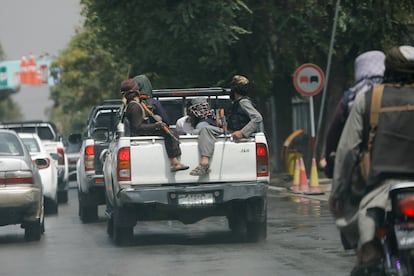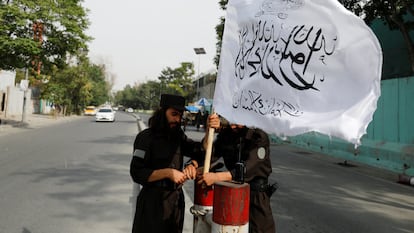The bulletproof Taliban-Al Qaeda alliance
The US-led war on international terrorism has failed to break the historic pact between Bin Laden and Mullah Omar

The ubiquitous photo of Osama Bin Laden and Ayman Al-Zawahri sitting together on the floor of a drab room is a symbol of the world’s most infamous terrorist outrage – the attacks on September 11, 2001. The US can now boast that it has fully decapitated the Al Qaeda terrorist group. The first head – Bin Laden – was severed in May 2011 in Pakistan. The second head – Bin Laden’s successor, Ayman Al-Zawahri – was severed on July 31, 2022 in Kabul (Afghanistan). Both were killed during extremely sensitive operations that required state-of-the-art technology and on-the-ground support to carry them out. Like former President Obama before him, President Joe Biden publicly celebrated the successful missions, because both knew that these targeted attacks by the US had a greater public impact than if the two terrorists had died in combat.
Years before 9/11, Bin Laden sealed a pact with Mullah Mohamed Omar, who founded the Taliban movement in Kandahar (southern Afghanistan) in 1994. This alliance gave refuge in Afghanistan to the Saudi-born terrorist after the attacks he directed against the United States. The protection offered by Omar led former President George W. Bush to order the 2001 invasion that kept US troops on Afghan soil for the next 20 years. Negotiations held in Qatar between the United States and the Taliban culminated in the 2020 Doha agreement to end the occupation during the Trump administration. The Doha agreement set out a timeline for US troop departures, and Afghanistan agreed not to provide safe haven for terrorists. But a Taliban-controlled Afghanistan instead proved to be fertile ground for Al Qaeda.
When Al-Zawahri took up residence in the center of Kabul, an impossibility without Taliban approval, the Doha agreement effectively perished. The Al Qaeda leader’s presence in Kabul also confirmed that the alliance between Bin Laden and Omar, who died in 2013, has remained intact over the years and outlived both leaders. Riccardo Valle, a political scientist with the University of Trieste (Italy) says, “The fact that he was in Afghanistan, as many predicted, is not a surprise. And according to the Taliban, it is not a violation of the Doha agreement because of its many loopholes.”
The Taliban factions
Although he cannot say for sure that the attack on Al-Zawahri had help from the inside, Valle notes that various Taliban factions differ in how to deal with Al Qaeda. “It seems that the Taliban are divided – some want to keep Al Qaeda quiet, but still allow them in Afghanistan. Others, like the Haqqani network, are closer to the terrorist organization and want to build it up.” This semi-autonomous faction of the Taliban is in charge of security in Kabul and is led by Minister of the Interior Sirajuddin Haqqani, an avowed anti-US hawk.

The Taliban seized control of Kabul on August 15, 2021 after the calamitous withdrawal of international coalition troops and the surrender of the Afghan army. It is unlikely that the surgical drone attack that killed Al-Zawahri will be able to erase the blot on Biden’s legacy left by the chaotic departure of US troops from Afghan soil. “The Taliban will probably continue to harbor Al Qaeda and other organizations. Their approach to these groups may change, but the mutual solidarity will endure,” predicts Valle.
International organizations still working in Afghanistan say that people feel more secure in their daily lives and can travel freely around the country. If this is true, the glaring paradox is that the Taliban themselves were the ones terrorizing Afghanistan and launching indiscriminate, lethal attacks against foreign troops, local security forces, and civilians.
As the first year of the Taliban’s second regime (the Taliban first held power from 1996-2001) comes to an end, the main threat it faces is the Islamic State (ISIS). ISIS was born in Iraq as an Al Qaeda splinter group, but has developed a very different brand of terrorism. Since the mid-2010s, ISIS has had its own terror franchise in Afghanistan that goes by the name Islamic State – Khorasan Province (ISIS-K).
Tu suscripción se está usando en otro dispositivo
¿Quieres añadir otro usuario a tu suscripción?
Si continúas leyendo en este dispositivo, no se podrá leer en el otro.
FlechaTu suscripción se está usando en otro dispositivo y solo puedes acceder a EL PAÍS desde un dispositivo a la vez.
Si quieres compartir tu cuenta, cambia tu suscripción a la modalidad Premium, así podrás añadir otro usuario. Cada uno accederá con su propia cuenta de email, lo que os permitirá personalizar vuestra experiencia en EL PAÍS.
¿Tienes una suscripción de empresa? Accede aquí para contratar más cuentas.
En el caso de no saber quién está usando tu cuenta, te recomendamos cambiar tu contraseña aquí.
Si decides continuar compartiendo tu cuenta, este mensaje se mostrará en tu dispositivo y en el de la otra persona que está usando tu cuenta de forma indefinida, afectando a tu experiencia de lectura. Puedes consultar aquí los términos y condiciones de la suscripción digital.
More information
Últimas noticias
Most viewed
- Sinaloa Cartel war is taking its toll on Los Chapitos
- Oona Chaplin: ‘I told James Cameron that I was living in a treehouse and starting a permaculture project with a friend’
- Reinhard Genzel, Nobel laureate in physics: ‘One-minute videos will never give you the truth’
- Why the price of coffee has skyrocketed: from Brazilian plantations to specialty coffee houses
- Silver prices are going crazy: This is what’s fueling the rally











































